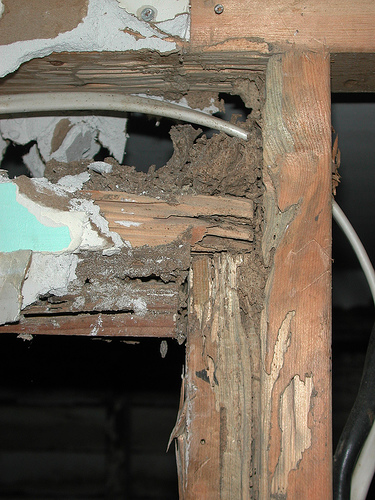How Did Termites Get Into My House?
By Chris Williams on June 26, 2014.

Wood damaged by termites in a home
Homeowners are usually surprised when they discover, or are told, that they have termites in their home. How could this happen? It shouldn’t, but the right combination of wrong circumstances can result in a termite infestation.
Subterranean termites like we have in New Hampshire and Massachusetts live in colonies in the soil and travel through soil to reach wood that they feed on. Because they are soft-bodied, termites dry out quickly when exposed to air and must remain in the damp environment inside soil or wood. They randomly forage until they find a stump or a piece of buried wood, or access to wood in a structure. Then they recruit others in the colony.
Your Home Should Be Protected By a Professional Termite Treatment
When homes are built, the soil around the foundation is pretreated with a pesticide to repel or kill any termites that try to reach the wood. If your home has been adequately protected with a perimeter treatment or with termite bait monitors, foraging termites should not be able to reach your home. However, barrier treatments don’t last forever; if it’s been 10 years since your home was treated, the pesticide may no longer be effective.
Termites Are Opportunists
During their foraging, termites explore all possibilities. There are several ways that they can enter homes:
- Through structural faults like cracks in the slab, openings in foundation walls for utility lines, and expansion joints.
- Termites sometimes build exploratory mud tubes over impediments and up foundations to reach wood that is above ground.
- If you have had landscaping, utility installation, renovations, or any kind of digging around your foundation, the protective soil barrier around your house may have been broken, letting termites move through and reach your house.
- If wooden structures outside your home such as decks, porches, trellises, planter boxes, or fence posts are touching soil and also touching the exterior walls of your house, termites can move from the soil through the structure and into your home.
Got Water-Damaged Wood?
Even if termites can reach the wood in your house, it doesn’t mean that they will move in. Subterranean termites usually don’t attack sound, dry wood; they prefer wood that is rotting or has been softened by moisture. In rare cases, moisture levels can be high enough in a part of the home, that termites can survive without soil contact.
Wood in homes becomes wet because of roof leaks, plumbing leaks, excessive condensation or humidity, poor foundation drainage, missing or faulty gutters or downspouts, leaky appliances, leaky windows, poorly adjusted sprinklers, etc. If you have had any of these situations, your home is at greater risk of termite infestation unless the problem has been repaired and the damaged wood replaced.
If you have termites in your home, or think you might have termites in your home, or are just worried about whether your home is protected – give Colonial Pest a call.
Photo credit: Editor B / Foter / Creative Commons Attribution 2.0 Generic (CC BY 2.0)